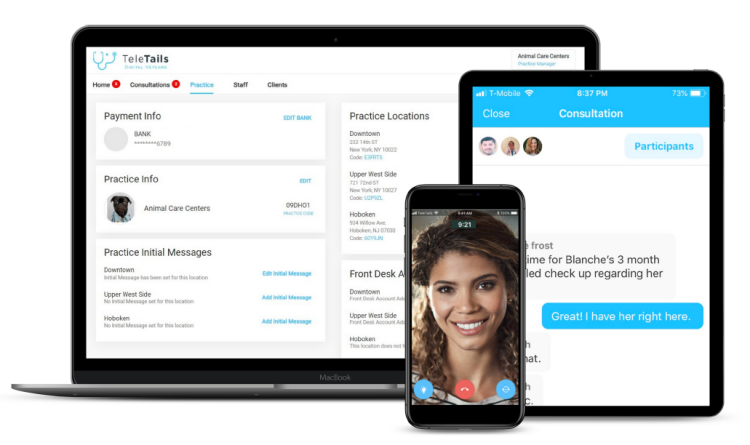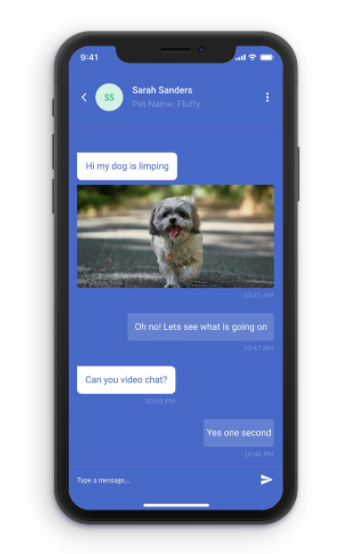As communities across the country continue to isolate to fight the COVID-19 pandemic, doctors' offices, health clinics, and veterinary clinics are moving their client-patient relationships online. Just a few months ago, telemedicine and telehealth, which includes non-clinical services, were still relatively uncommon practices. Now, they are more necessary than ever.
Here, we’ll give you an introduction to how you can implement a veterinary telemedicine program at your practice. We’ll also explore a few of the platforms available to help you facilitate it.
- How veterinary telemedicine works
- Benefits to vets and pet parents
- The difference between teleheath and telemedicine
- It's limitations
- Does telemedicine work with pet insurance?
- COVID-19 Update from the FDA
- Veterinary telehealth companies and the telemedicine platforms you should consider
How Veterinary Telemedicine Works
Veterinary telemedicine services work in much the same way as human telemedicine. Clients will request a visit, providing information about their animal’s condition. The veterinarian schedules the visit and both parties meet via a digital channel to discuss the animal’s care. During the visit, the veterinarian provides a diagnosis, recommendations for treatment, and perhaps even a prescription recommendation.
According to the AVMA, veterinary telemedicine is “the use of medical information exchanged from one site to another via electronic communications regarding a patient’s clinical health status.” A telemedicine session can take a variety of forms. The most basic type of telemedicine service is a phone call, but veterinarians can also make use of software platforms and other types of equipment to provide more in-depth care remotely. Often, all you need is a laptop computer, a tablet, or even a smartphone.
The AVMA stresses that veterinarians should only use telemedicine within the context of an existing veterinarian-client-patient relationship (VCPR), in which the veterinarian has previously conducted a physical examination of the pet. The AVMA also released a report on veterinary telemedicine, which includes key recommendations for how to implement it at your clinic.
 (Source: CBC News)
(Source: CBC News)
Telemedicine benefits for vets and pet parents
Veterinary telemedicine services can improve client relationships and boost revenue. Having an additional channel to interact with pet parents should always be considered, especially a digital solution that feels modern and matches current patient behaviors.
Millennials in particular will appreciate streamlined digital experiences. They’re one of the largest driving forces behind pet care growth, so telemedicine services like video call appointments and real-time online veterinarian advice or chats could be very much worth the consideration. Enabling pet parents to fit veterinary appointments more seamlessly into their schedules may very well increase their overall “visitation” rate - which is better for vets and pets.
More importantly, veterinary telemedicine can help sustain your practice during national emergencies - like the current pandemic sweeping the globe. With the nation in self-quarantine and practicing social-distancing, telemedicine services can be a critical component in maintaining business and providing needed care.
Telehealth vs telemedicine - what’s the difference?
Telehealth refers to a broad scope of remote healthcare/petcare services. Telehealth is a category that includes both remote clinical services and remote non-clinical services (training, administrative meetings, and continuing veterinary education). According to the World Health Organization, telehealth also includes, “Surveillance, health promotion and public health functions.”
Telemedicine is a subset of telehealth that refers specifically to remote clinical services - the actual patient-veterinarian appointment held online (or over the phone) to diagnose health and treatment. When you administer clinical services via telecommunications or software, that’s called telemedicine. It’s generally used for follow-up visits, managing chronic conditions and medication, specialist consultations, and a host of other clinical services (especially amid the COVID-19 coronavirus pandemic).
The Limitations of Veterinary Telemedicine and Online Advice
Naturally, there are some limitations to providing veterinary care remotely. It can be challenging to diagnose an animal when you can’t physically examine them. A poor internet or wireless connection, low-resolution imaging, and other technical difficulties can also hinder your ability to provide care, especially when you need a clear view of the animal’s symptoms.
Nonetheless, many of these issues can be solved on the client’s end by connecting via their smartphone, if they have one, through a secure internet connection. It’s also worthwhile for your business. According to Today’s Veterinary Business, 85% of pet owners find a connection to their veterinarian via telehealth appealing. To ensure you have a clear connection to provide effective care and advice online, you can also use a veterinary telehealth platform.
Does telemedicine work with pet insurance?
Yes! After speaking with our pet insurance partners at ASCPA, Fetch by The Dodo, PetsBest, Pet First, and Hartville - all accident and illness claims are business as usual through telemedicine. Pet insurance companies rely entirely on the veterinarian’s notes for sending reimbursements (and the coverage details outlined in the pet owner’s policy).
However, new pet insurance customers should be aware that if their provider requires an in-person appointment to establish baseline health, a telemedicine appointment might not suffice (note: most pet insurance providers do not require this).
Also, Routine visits normally covered under wellness plans may not be eligible under virtual appointments. Pet parents should double-check with their chosen provider to see if telemedicine will suffice for routine care or if a curb-side appointment may be necessary.
COVID-19 Update: The FDA suspended veterinarian-client-patient relationship (VCPR) requirements to facilitate veterinary telemedicine during the current pandemic
“This will allow veterinarians to prescribe drugs in an extralabel manner or authorize the use of VFD drugs without direct examination of or making visits to their patients, which will limit human-to-human interaction and potential spread of COVID-19 in the community” - fda.gov (March 24, 2020)
You’ll still want to check with your state veterinary licensing board for details on what this means for your practice specifically.
For additional resources, explore the COVID-19 HUB For Veterinary Teams.
Veterinary Telehealth Companies and the Telemedicine Platforms You Should Consider
If you need to start providing remote veterinary medicine services immediately, you can start by using whatever existing computing technology you have at your practice - like video calling and note taking. But if you’d like to build upon your telemedicine program, you should explore some of the tools available on the market.
Here are a few you should consider.
Anipanion
Anipanion is a veterinary telemedicine platform that connects vets with their clients through video chat technology and a downloadable app. Clients can chat with vets using the app’s chat request feature, and they can send pictures and videos of their pets to help their vet provide a diagnosis.

Veterinarians can use the platform to securely store notes, video logs, and chat logs, all of which can also be made accessible to clients. The platform integrates with IT and workflow tools like Next In Line, IDEXX, and PawTech.
The platform starts at $99 after a free 30-day trial.
VetNOW
Like other veterinary telemedicine platforms, VetNOW is a cloud-based tool that allows veterinarians to deliver telehealth services to their clients. But the platform also connects vets to a network of specialists remotely, enabling them to collaborate with board-certified specialists on an animal’s care.

The platform includes a portal in which vets and specialists can share information from diagnostics tools with the client and with each other. Access to specialists requires a monthly subscription and costs $179 per call.
TeleTails
TeleTails provides veterinarians with live video consultations and messaging tools that can support pictures, videos, and other types of attachments. The platform can collect payments automatically from clients after a consultation, and it will automatically send a PDF containing notes, messages, and pricing information to the vet’s practice information management system (PIMS).
 (Source: New York State Veterinary Medical Society)
(Source: New York State Veterinary Medical Society)
Clients can connect with their vet through a downloadable app. Pricing information isn’t immediately available.
TeleVet
TeleVet is another veterinary telemedicine platform that lets you schedule and conduct virtual consultations via video, phone, or instant messaging. Like TeleTails, it also includes payment processing, so you can deposit client payments directly through the app. However, the platform also includes a marketing component that lets you share automated messages and promotional codes directly to clients through their smartphone app.

TeleVet lets you set roles for members of your team, and it includes integrated scheduling and clinic management features. You can even track the effectiveness of your marketing.
TeleVet starts at $79/month, which includes unlimited users, training, and live support.
GuardianVets
GuardianVets is multiple platforms rolled into one. The Continuity of Care platform provides triage support, connecting clients with licensed experts when their primary veterinarian isn’t available. The telemedicine module enables vets to schedule and conduct virtual consultations through calls, SMS, and video chat. Clients can connect with their vet through a smartphone app.

GuardianVets is designed to work alongside existing practice management software.
Get Started with Veterinary Telemedicine Services
Pet health doesn’t have to wait until you see the patient in-person - it’s 2022! Whether you’re adapting your practice to cope with the coronavirus pandemic or you’re interested in expanding your capabilities, veterinary telemedicine should soon be a part of your business model.
Have a specific question?
Ping us at fetch@pawlicy.com
